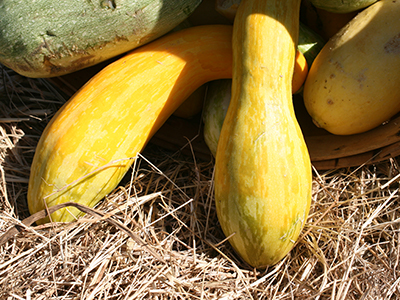Summer Squash

The name summer squash is used to describe squashes that have a thin, edible skin. Zucchini, yellow squash, crookneck, and pattypan are the most common summer squashes grown in Florida. Summer squashes are usually bush types and have less of a spreading, vining habit than winter squashes.
Despite the name, summer squash doesn’t really grow in Florida during the heat of the summer. It can be grown in North Florida from February to April as well as in August and September. In Central Florida it can be grown from February to May, and again in August and September. And in South Florida it can be grown from August to March.
Most of the zucchinis grown for market in Florida are grown in the north and central parts of the state, while most of the yellow squash grown for the commercial market comes from the central and southern parts of Florida.
Characteristics
Summer squash (Cucurbita pepo) is a member of the Cucurbitaceae family; interestingly, zucchini, yellow squash, crookneck, and pattypan are all the same genus and species. The skin and seeds of these squash are edible. Their tender flesh has a high water content, mild flavor, and cook up quickly. Summer squash is a good source of folate, potassium, and vitamins C and B6. Unpeeled squash can be high in vitamin A as well. Summer squash can be eaten cooked or raw, and recently have gained popularity as a vegetable alternative to noodles, called “zoodles”.
Zucchini
Zucchini are usually green in color, however cultivars offer a range of colors, from yellow to a green so dark it almost looks black. Zucchini cultivars can even be found with skin that is striped. Generally, zucchini are cylindrical in shape, however cultivars that grow in a spherical shape can be found.
‘Caserta’ is an average-sized variety for zucchini squash that reaches between 5 and 6 inches long. ‘Cocozelle’ is quite long, reaching 14 to 16 inches in length. Eight-ball zucchini offers something a little different, giving you the classic zucchini taste in a round ball shape.

Creative Commons BY-NC-SA.
Yellow
Yellow squash resembles zucchini squash except it has skin that is pale yellow in color. These come in two varieties, straight neck (which has a fat bottom that slims to a tapered neck) and crookneck. They can have smooth or slightly bumpy skin and cream colored flesh with large seeds.
Crookneck
Crookneck squash are distinguished by their shape; the squash tapers from a bulbous blossom end to a curved, narrow stem end. With yellow, slightly bumpy skin crookneck squash have a mild flavor.
Pattypan
Pattypan is a small squash that has a round, shallow shape and scalloped edges. This interesting-looking squash is as delicious as it is eye catching. They can be found in white and shades of green and yellow and can truly give you something a little aesthetically different to grow in your garden.
Planting and Care
Some varieties for growing in Florida include ‘Early Prolific Straightneck’ (bush-like yellow squash), ‘Summer Crookneck’ (yellow crookneck squash), ‘Early White Scallop’ (white pattypan squash), ‘Cocozelle’ (very long, dark green zucchini with light green stripes), ‘Spineless Beauty’ (medium green zucchini on plants with very few spines), and ‘Black Beauty’ (glossy dark green zucchini).
Summer squash should be planted in an area that gets full sun in rows that are spaced three feet apart. Within each row, plants should be given two feet of space between each plant. Seeds should be planted an inch to an inch and a half deep in the soil. Plant either seeds or containerized transplants (transplants that have developed mature roots) in your garden. Four to six plants is generally able to produce enough fruit to feed a family of four. Mulching is a great way to conserve moisture in the soil and keep your squash out of the dirt.

Like all cucurbits, summer squash have male and female flowers separated but on the same plant. Pollination by insects or by hand is necessary for fruit to set. Wrinkled and premature fruit drop is a sign of poor pollination.
Summer squash takes between 40 and 50 days to produce fruit ready for harvest. It’s best to harvest your fruits by cutting the stem to a point where the fruit is left with an inch or two of intact stem. This will help your squash store longer. Be aware that you may want to wear gloves while harvesting your squash as stems can have sharp spines that may irritate skin. Frequent harvesting will keep your plant producing fruits.
While insects, mainly bees, are important for pollination of summer squash, these plants can be damaged by other insects. Leafminers, aphids, cutworms, squash vine borers, squash bugs, cucumber beetles, mole crickets, and fruit worms are insects that have been known to harm summer squash plants. Diseases like downy mildew, powdery mildew, mosaic virus, and fruit rots can also take a toll on these plants. Keep in mind that zucchini leaves have light greenish-gray splotches and streaks on the leaf surface, this is a natural feature of the leaf that is often mistaken for a mildew problem, so be sure to check before assuming disease.
To protect the bees that are so important for fruit set, avoid spraying for insect pests. If you absolutely must spray, do so only in the evening when bees are less active.
Also on Gardening Solutions
- Edible Flowers
- Powdery Mildew vs Downy Mildew
- Three Sisters for Florida
- Vegetable Gardening by Season
- Winter Squash
